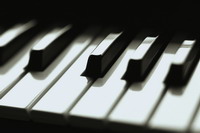Piano Sheets > Terry Gilkyson Sheet Music > Bare necessities (ver. 2) Piano Sheet
Bare necessities (ver. 2) by Terry Gilkyson - Piano Sheets and Free Sheet Music

About the Song
Other avaliable versions of this music sheet: Version 1 Version 2
"The Bare Necessities" is a song, written by Terry Gilkyson, from the animated 1967 Disney film The Jungle Book sung by Phil Harris as Baloo and Bruce Reitherman as Mowgli. It was written for an earlier, rejected, draft of the movie, and was, as the only song of that version, kept, on the request of the Sherman Brothers, who wrote the other songs of the film. A reprise of the song was sung by Sebastian Cabot as Bagheera and Phil Harris as Baloo at the end of the film. The song was also sung by Louis Armstrong.
In 2005, Julie Andrews recorded the song for her album "Julie Andrews Selects Her Favorite Disney Songs", Tituss Burgess Performed The Song For The BBC Radio Special "BBC Radio 2 Celebrates The Music of Disney" and, Bowling for Soup recorded it for Disney's DisneyMania 3 Album.
In Disney's 1994 live-action film, Dr. Julius Plumford says "The bare necessities of life!" in the ballroom.
Download this sheet!
About the Artist

Random article
Everything about piano sheet music Sheet music has a history of its own, dating back to the 19th century. In those days, musicians would play classic compositions using sheet music piano. Later on, when bands started performing, music sheets were back in vogue as a means to recreate these old compositions.
What is it?
Sheet music is nothing but a written notation of the piano notes. Depending on what musical composition the sheet music is for, the musical notes written will also differ. Most people have a wrong notion that it is only the popular compositions, which have recorded onto sheet music piano. However, several unfamiliar compositions have also been recorded using sheet music.
(More...)
